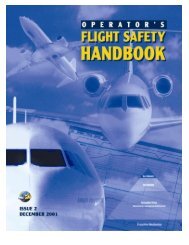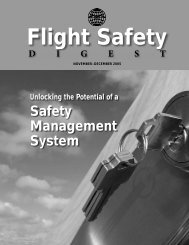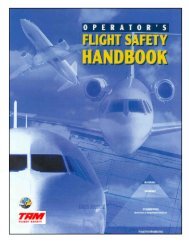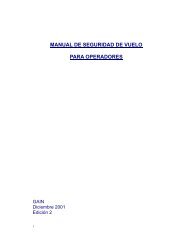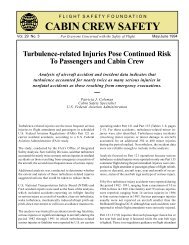Flight Safety Digest October 2005 - Flight Safety Foundation
Flight Safety Digest October 2005 - Flight Safety Foundation
Flight Safety Digest October 2005 - Flight Safety Foundation
You also want an ePaper? Increase the reach of your titles
YUMPU automatically turns print PDFs into web optimized ePapers that Google loves.
2<br />
C ONVERSATION ANALYSIS<br />
aircraft under the control of the fl ight crew is<br />
fl own unintentionally into terrain, obstacles or<br />
water, usually with no prior awareness by the<br />
crew.]<br />
As a result of the BASI research, the ATSB contracted<br />
independent specialists in an emerging<br />
fi eld known as “conversation analysis” to analyze<br />
the CVR from the Westwind accident. The project<br />
was conducted by Maurice Nevile, Ph.D., and<br />
A.J. Liddicoat, Ph.D., both then of the Australian<br />
National University. The independent consultants’<br />
report provided conclusions regarding the crew<br />
interaction that were consistent with the original<br />
BASI investigation report. More important, the<br />
project showed that the conversation analysis<br />
method provided a very useful approach to<br />
identify, describe, demonstrate and explain diffi<br />
culties in conversation between two or more<br />
individuals.<br />
This paper discusses the nature of conversation<br />
analysis and its potential for use in safety<br />
investigation, as well as its potential for demonstrating<br />
the importance of appropriate crew<br />
communication practices. To help explain the<br />
usefulness of the method, information from<br />
the original consultancy project’s examination<br />
of the Westwind CVR is included. This paper<br />
is not an investigation of the circumstances of<br />
the accident.<br />
It is important to note that a cockpit voice recording<br />
provides limited information about activity<br />
in a cockpit and cannot provide a complete<br />
understanding of all activities<br />
and interactions among fl ight<br />
crew. It does, however, provide<br />
a good understanding of what<br />
happened and why. The analysis<br />
can be enhanced by comparing<br />
average sound recordings from<br />
normal multi-crew communication<br />
and activity on a fl ight<br />
with a recording from a particular<br />
fl ight that is being studied.<br />
This comparison can provide<br />
more detailed insights into crew<br />
activities and interactions on a<br />
particular operation despite<br />
the lack of visual information<br />
— for example, from a cockpit<br />
video recording.<br />
It is acknowledged that a perfect understanding<br />
of cockpit activity is diffi cult to achieve without<br />
the opportunity to interview the fl ight crew as a<br />
part of an investigation. However, the methodology<br />
described in this paper is intended to expand<br />
the level of understanding that can be obtained<br />
from a cockpit voice recording as a part of an<br />
investigation.<br />
Executive Summary<br />
Recorded voice data, such as from CVRs or<br />
air traffi c control (ATC) tapes, can be an<br />
important source of information for accident<br />
investigation, as well as for human factors research.<br />
During accident investigations, the extent<br />
of analysis of these recordings depends on the<br />
nature and severity of the accident. However,<br />
most of the analysis has been based on subjective<br />
interpretation rather than the use of systematic<br />
methods, particularly when dealing with the<br />
analysis of crew interactions.<br />
This paper presents a methodology, called<br />
conversation analysis, which involves the detailed<br />
examination of interaction as it develops<br />
moment-to-moment between the participants, in<br />
context. Conversation analysis uses highly detailed<br />
and revealing transcriptions of recorded voice (or<br />
video) data that can allow deeper analyses of how<br />
people interact.<br />
The paper uses conversation analysis as a technique<br />
to examine CVR data from the Westwind<br />
accident.<br />
The conversation analysis methodology provided<br />
a structured means for analyzing the crew’s interaction.<br />
The error that contributed directly to<br />
the accident — an incorrectly set descent altitude<br />
— can be seen as not the responsibility of<br />
one pilot but, at least in part, as the outcome of<br />
the way the two pilots communicated with one<br />
another. The analysis considered the following<br />
aspects in particular:<br />
The significance of overlapping talk (when<br />
both pilots spoke at the same time);<br />
The copilot’s silence after talk from the pilotin-command<br />
(PIC);<br />
FLIGHT SAFETY FOUNDATION FLIGHT SAFETY DIGEST OCTOBER <strong>2005</strong>


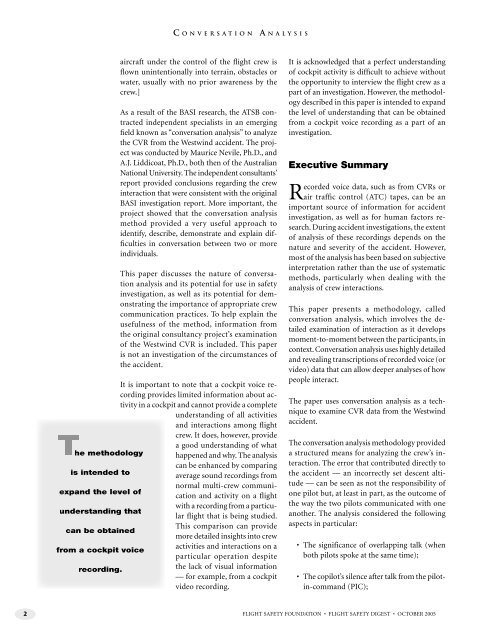

![Download this Issue [PDF 7 MB] - Flight Safety Foundation](https://img.yumpu.com/18859635/1/190x245/download-this-issue-pdf-7-mb-flight-safety-foundation.jpg?quality=85)
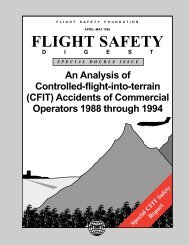
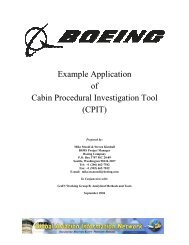
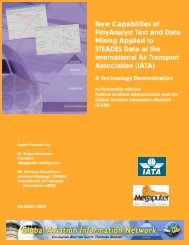
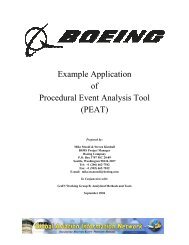
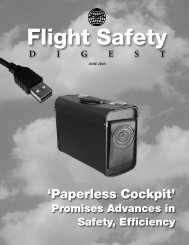
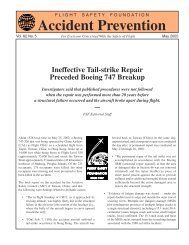
![Download [PDF 8 MB] - Flight Safety Foundation](https://img.yumpu.com/18859366/1/190x245/download-pdf-8-mb-flight-safety-foundation.jpg?quality=85)
